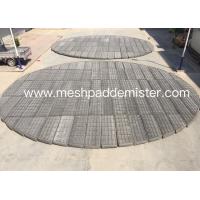Coarse prefilter wire mesh filter material with stainless steel
frame
1.General introduction of wire mesh demister
The wire mesh demister is used to collect the liquid particles
contained in the vapor phase after boiling, vacuum evaporation or
bubbling.
The small droplets in the gas contact with the wide surface of the
filament of the mesh demister, gradually grow into large droplets,
and flow and drop through a special structure to accelerate the
condensation of the droplets. The mesh mat of the demister is
highly porous, so the steam gas passes through the demister
unimpeded, leaving only pure gas.
This process is not a kind of filtration, because the aperture of
the woven mesh has no special relationship with the size of the
droplets. This demisting is caused by the collision and sudden
change caused by the flow velocity of small droplets, and the
condensation and gravity of droplets cause their decline.
This is a process of combining mechanical and physical phenomena.
2. Design of Wire Mesh Demister.
2.1 general
A. XXX project specification - vessel specifies size, style,
thickness, configuration and material.
B. The type of demister is defined as follows:
C. Type G is a mesh blanket with variable weaving density. The
density of steam inlet is the lowest, and that of outlet is the
highest. Typical inlet / outlet knitted mesh densities are 5 lb/ft3
(80.1) and 9 lb/ft3 (144.2). Customers can request variable density
blankets with slightly different weaving density and wire diameter.
Type V shall be determined by the supplier according to the process
conditions provided by the customer. The supplier can determine the
type of demister that is most suitable to meet the demist
requirements. The selected style may include grid pads, blades, or
a combination of grid and blades. The demister can be oriented
vertically, horizontally or at an angle determined by the supplier.
Single pads of variable knitting density may also be used.
2.2 construction
A. The demister shall be fabricated as a whole or as the minimum
number of sections required to be inserted into the vessel manhole.
B. The mesh gasket shall closely cooperate with the gasket sealing
system.
C. The thickness of mesh bedding shall not exceed 9 inches (230
mm). If more than one layer is required, the joints shall be
staggered.
D. The integrated circular mesh pad can be spiral.
2.3 supports and gratings
A. In addition to the customer's requirements, the general layout
of the demister support and grille shall comply with the factory
practice.
B. The mist eliminator supplier can also provide final details of
the mist eliminator support and compression grille.
C. The demister supplier shall provide details of the components
attached to the vessel to the vessel manufacturer in a timely
manner for installation without changing the vessel manufacturing
progress.
D. Each part of the mesh mat shall include a grid on each side.
E. G-type mesh mats shall be provided with inlet and outlet rigid
welded gratings. The outlet grille and blanket outlet area of the
G-type mesh mat shall be clearly marked with "outlet".
F. Spiral mesh mats shall include an x-mesh on both sides.
2.4 fastening device
As a mist eliminator manufacturer, we can provide ties or other
devices to fix the mist eliminator part to the bracket, connect the
grille to its container bracket, and fix the layers together if
multiple layers of mist eliminators are required.
3. Main types of wire mesh demister
Mesh Density | Eq to: YORK | Description |
| 80 | 931 | For a given load of mist, the highest flow velocity is achieved of
all styles. Ideal where it is required to minimize the pressure
loss, possible clogging is concerned, the size of particle to be
collected is relatively large, and/or a very high efficiency is not
required. |
| 144 | 431 | Used for general purposes. An efficiency of 98 to 99% is achieved
at a velocity of 1 to 5 m/sec. |
| 192 | 421 | Used where an especially high efficiency is required. While a
pressure loss is slightly higher, it achieves an efficiency of 99
to 100% with particle sizes 3μ or more at a velocity of 1 to 6
m/sec., and is ideal where an efficiency of 90% or more is required
at a velocity of 1 m/sec. or less. |
| 216 | | Used for collecting fine particles of 1 to 3μ in size.
Especially for a low-density mist of 1.0 g or less, it is used in a
thickness of 200 to 300 mm. |
| 432 | 333 | Used for collecting fine particles. An efficiency higher than that
of 216 can be achieved. The most remarkable characteristic is that
it provides a high efficiency with a reduced thickness. |
Wire Mesh Demister Package:










